The early years of school are an exciting time, with new people to meet and new experiences to be had. It is a time where children develop their personalities and foster cognitive skills, and it is the job of teachers to create a positive and supportive environment which allows these attributes to grow.
"Creative exploration promotes experimentation and builds confidence."
The central focus for any early years / Primary classroom should be creative exploration, allowing children to bring their ideas to life in a real way, which promotes experimentation and builds confidence, as they can see the positive results of their work. Surrounding this, there are three key areas for development: social and emotional skills, which help children learn to interact with others; language and literacy, which stimulate their language development; and Maths and Science, which promote early problem-solving skills.
All of these elements can be explored through a cycle of constructing, contemplating and reconstructing ideas, using hands-on and creative activities to stimulate engagement and help children to enjoy their learning. Here are some ideas for what you could use in the classroom to inspire pupils in lessons:
Social and emotional development
This is possibly the most crucial element of early childhood, simply because it will form the foundations for how pupils will interact with others, possibly for the rest of their lives. In order to foster positive relationships, children must be able to understand their own emotions and the feelings of others, while identifying the similarities and differences between people, developing a sense of self and belonging within an increasingly global community.
In order to inspire discussion around this, you could tell a story that involves characters feeling a variety of emotions, before asking pupils to build or draw a representation of those feelings: what does ‘sad’ look like? What does ‘angry’ look like? Following this, you can then ask the pupils about times when they have felt like the characters in the story. If they were sad or angry, what made them feel better? If they were happy, did they try and make others around them happy too? Sometimes, pupils can find it hard to discuss things that make them feel sad, but by opening the discussion in the safe space of the classroom, children will feel more supported and able to address their feelings and the situations that cause them.
To develop teamwork and interpersonal skills, you could create a collaborative scenario, like a café, where pupils"You could ask them to build a story scene-by-scene and describe it to the class." role play various people in the scene, deciding who will be responsible for what and determining how these roles interact. The customer will discuss their order with the waiter, who will take this to the chef. The chef then prepares the meal and the waiter takes this back to the customer. This situation also requires children to work on their communication skills by providing instructions and feedback to make sure that everyone understands!
Literacy and language
In every lesson, you can encourage pupils to use new words which will expand their vocabulary. When looking into literacy specifically, you can use creative prompts to get pupils’ imaginations going. For example, you could ask them to build a story scene-by-scene and describe it to the class, using phrases to signpost parts of the tale, such as “Once upon a time”, “all of a sudden” and “in the end”. This helps to build grammatical knowledge and understanding of narrative structure.
This form of storyboarding lends itself well to early writing, as the pupils are able to visualise their ideas and discuss them before putting pen to paper. Children could even act out the story to better understand the themes and work on their speaking and listening skills! Changing the perspective of the story can also develop this further, using new words and discussing different issues. If there is a villain in the story, ask pupils to retell the events from their perspective!
Maths, Science and problem-solving
It is crucial to spark an interest in Science and Maths from an early age, as these are the subjects that often fall victim to the labels of “difficult” or “boring” later on in school life. Showing children how fun and inspiring technical subjects are can be a challenge, but by using creative exploration, pupils will be able to see it for themselves. You could talk about animal categorisation in both a mathematical and scientific context, using hands-on activities to group animals in a variety of ways. For example, group animals by species and count the individual numbers, and then divide these species into classes, such as mammals or reptiles, and then calculate the number of animals in these categories.
In exploring how things work, you can also give pupils the opportunity to create their own ideas. For instance, you could look at how aeroplanes actually manage to fly and ask the class to design their own plane, describing what features could be added to improve the flight of the vehicle. This playful experience allows them to enjoy the lesson, while still looking into the key concepts of gravity and physics that will be explored in greater detail as they move through school.
To conclude
Children are naturally creative, and in order to encourage their talents, we should be nurturing this creativity, rather than forcing it into a box-ticking process. It’s no secret that when children are having fun, they learn more about the topic as their engagement is greater. By allowing them to see subjects in a playful manner, they will be more enthusiastic about them later in their school careers, and they will have developed the cognitive and personal skills needed to work with others in their class more effectively.
Are you an EY or Primary teacher? Share your experiences below.


















